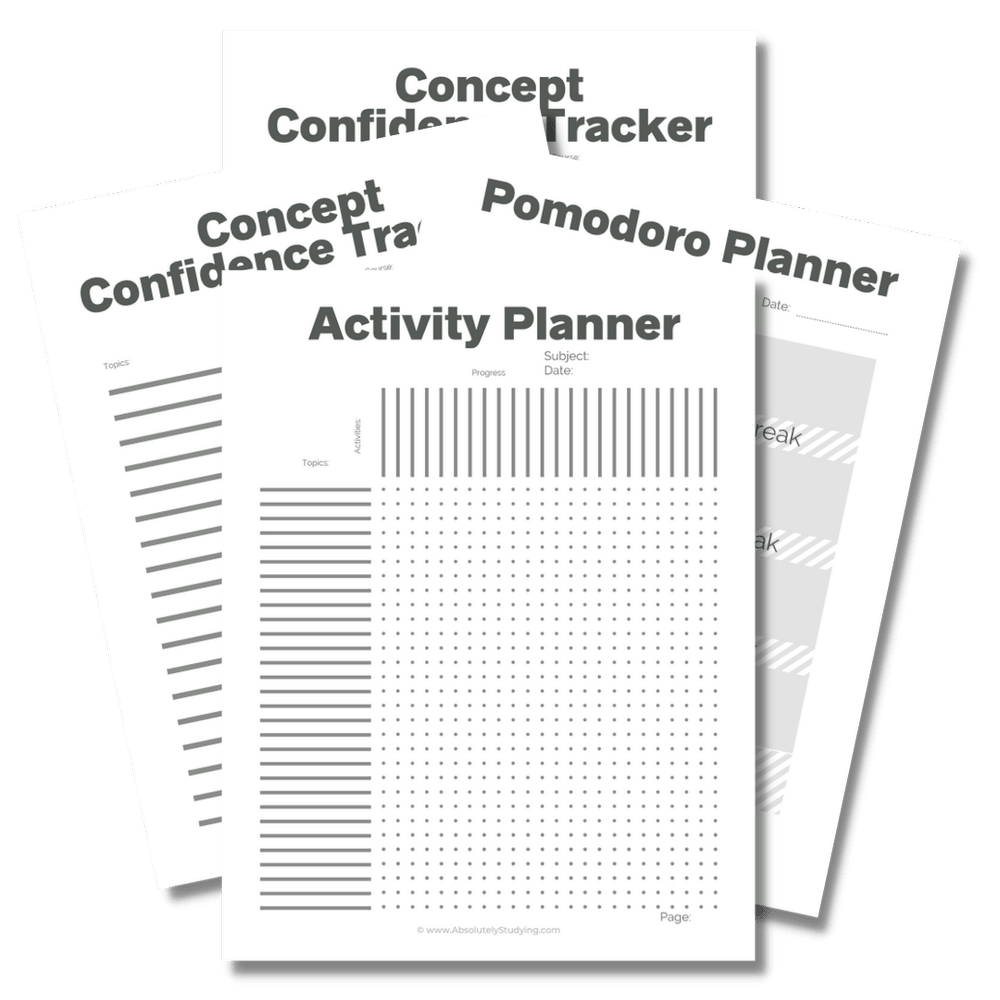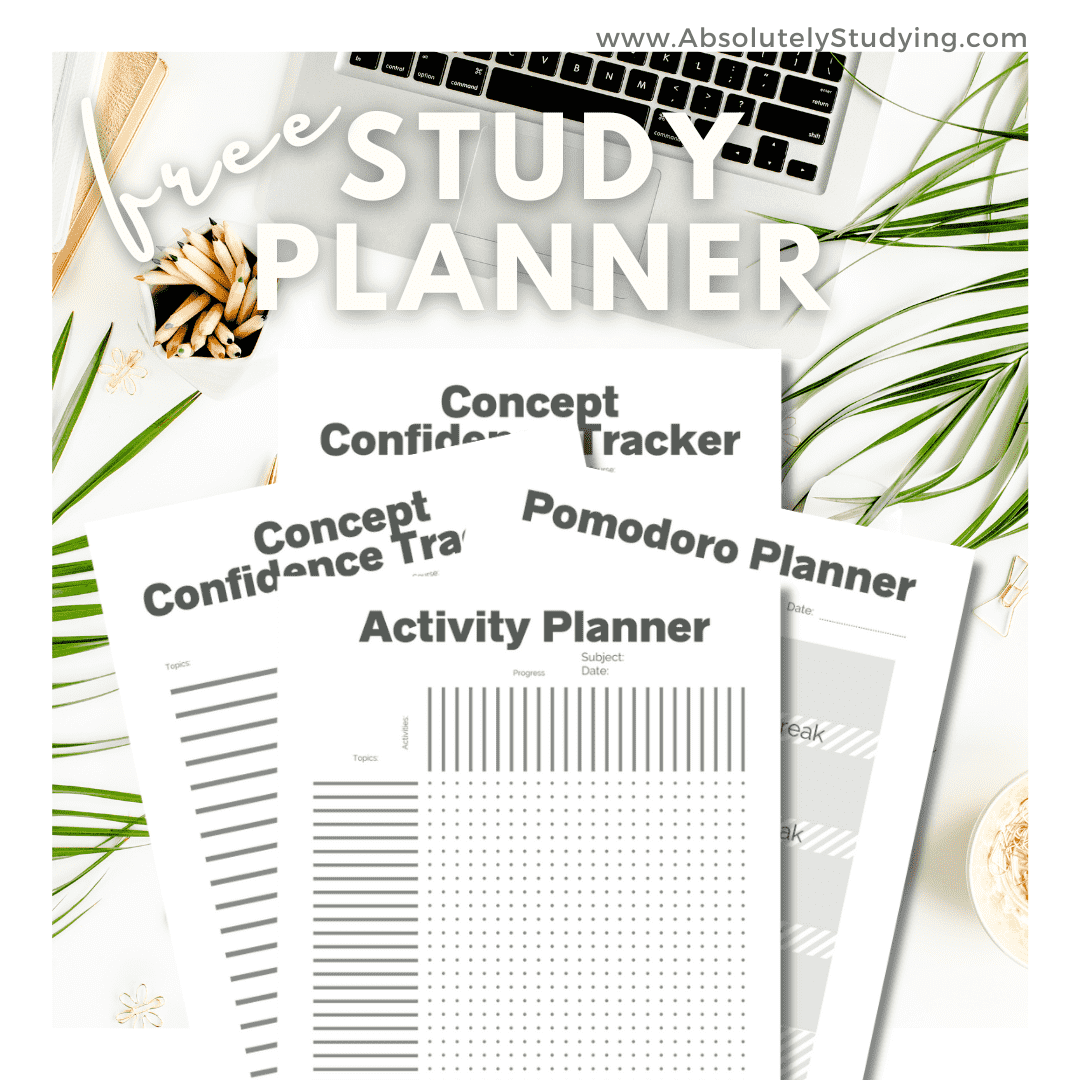How the Pomodoro Technique Can Transform Your Study Habits
How the Pomodoro Technique Can Transform Your Study Habits
Try this time-management strategy will actually boost focus and productivity.
Everything you need for the semester you want!
This bundle includes:
The Syllabus Study Planner
The Pomodoro Planner
A Confidence Tracker
A Q&A planner
The “Get Organized Checklist”
and more!
This workbook is full of super useful resources that can be applied to every aspect of your day.
* Disclaimer * Some of the posted links are affiliate programs. By clicking these links, I may receive monetary compensation. This will not alter the price or change the buyer's experience.
The hardest part of studying for me has always been focus. I’ve always found holding my focus, especially for several hours, incredibly difficult. I have the attention span of a squirrel. I am often thinking about two or three different things all at once.
As I read my textbook, I need to consciously fight the effort to phone a friend, create my shopping list, and recount any awkward situations or conversations I found myself in the day before. Having to fight off all of these intrusive thoughts is exhausting. Trying to retain the information I’m reading while living through this multi-tasking is sometimes impossible.
One system that I have found to be incredibly helpful is the Pomodoro Technique. This is because it breaks up my efforts into short, digestible pieces. When I first tried the Pomodoro Technique, I admit I found it very frustrating. I felt the focus intervals were not long enough, and I could still continue to focus past the short 25-minute blocks. I found the brakes intrusive. I was constantly taking down time rather than working, which added to the guilt of not studying enough. I heard so many times that the Pomodoro Technique is really helpful, and I wanted to stick it through and persist. I wanted to see what these benefits were, so I kept with it.
Once I learned to trust the process, the benefits were finally revealed. Overall, I could focus for hours longer than my traditional study methods. Instead of tapping out after a few hours, I could study all day if needed. I could also bounce back and still have the ability to focus the following day for just as many hours.
Many times after marathon study sessions, I found that I would almost have a focus hangover the following day. I would feel groggy and exhausted, as if I had sprained my brain. I would not be able to spend long periods studying, focusing, or working. This was obviously a problem. I could not sacrifice one study marathon for days of distraction.
When I started using the Pomodoro Method, I had no problem focusing the following day. I would still be able to concentrate, study, carry on as usual and even partake in a second marathon session, provided I continue taking frequent breaks.
The short 25-minute focus intervals allowed me to concentrate deeper. I felt more willing to turn off the notifications on my phone and purge anxious thoughts. I found that writing down my nervous feelings allows me to put these intrusive notions out of my mind. I can then address them during the five-minute breaks.
I cannot tell you how crucial the Pomodoro Technique is, not only in my study sessions but even in my business. In this article, I am breaking down exactly what the Pomodoro Technique is, why it is so effective for studying, how it works, and the benefits of the Pomodoro technique in relation to ADHD.
If you struggle to find more effective study habits, check out my free study planner. It has everything you need to create a comprehensive study guide for any exam or the entire semester. It even comes with a Pomodoro Planner to make the most of every single study session. You can download it here.
DOWNLOAD NOW: FREE STUDY PLANNER AND ACTIVITY TRACKER
Study Guide Template
Download your free study guide template. It has everything you need for the grades you want.
What is The Pomodoro Technique?
The Pomodoro technique is a chunking method intended to optimize productivity and time management while minimizing burnout. This technique allows for four sessions of intense focus over 2 hours. There are four periods to get things done within this time, with breaks scheduled in between.
Each of these 25-minute blocks of active time is designed to maintain an extreme level of focus. The first three periods are broken up by 5-minute breaks to rest fully and step away from the desk. The fourth 25-minute focus interval is followed by an extended 20-minute break before the timer ultimately resets again.
These sessions are the ideal amount of time to completely lose oneself, deep in focus and productivity. At first, the frequent breaks might seem to come a little too often. But, as you continue using this strategy, you will find that you are progressing through your work quicker while staying focused longer and more intensely during these periods. The next day, you don’t have that extra tired, burnt-out feeling that you usually feel after spending an entire day studying.
When you have a ton of work, layering these two-hour sessions one after another can help you plow through it. Because you’re taking such frequent breaks, it allows you to extend your ability to focus as long as you want. This is not simply limited to studying. You can implement the Pomodoro Technique while working on projects or assignments like essays or term papers. They can also be used to structure and organize your time. Assign any task you need to accomplish to one or more of the 25-minute focus intervals to exercise complete control over your time and productivity.
Why is The Pomodoro Technique Effective for Studying?
The Pomodoro Technique is effective because it is realistic. The short focus intervals are enough time for you to complete a task without exhausting your brain. You can pay attention to the task at hand and turn off all distractions for 25 minutes. This is doable, even for the most motivation-challenged of us.
It is also great for task management. Creating a list of tasks ranging from 5 to 25 minutes and then working through them in these blocks is not as intimidating as sitting down with a pile of books. You can create a game plan for 25 minutes. You can commit to 25 minutes. This is not scary or unimaginable. Take the study session one focus interval at a time, and plug away at your list.
You can also implement this strategy in any aspect of your life. The Pomodoro Technique can work to get nearly any list of tasks done. The positive reinforcement of the short breaks works as an incentive to tackle that to-do list. It also works as an easy productivity cycle. Allowing you to move around and juggle different tasks without committing to any of them.
I often use my 5-minute breaks to do quick chores I am generally uninspired to complete. Sometimes, it will be cleaning off my desk, sorting piles, or even doing laundry. I may not want to tackle these tasks head-on, but I am willing to do them for 5-minutes. These tasks also have the added reward of walking away from my desk for a few minutes, which allows my brain the rest it needs.
How the Pomodoro Technique Can Transform Your Study Habits
The Pomodoro Technique and ADHD.
The rotation between focus and rest can be extremely helpful to students with ADHD. When simply sitting still for prolonged periods is a challenge, frequent breaks can help regulate students’ restlessness.
Creating a schedule or a list of tasks to tackle during each focus interval will keep your attention fresh for 25 minutes. This means that you will do something different every time you sit down to do a study activity. This can also help to keep you engaged and concentrate more easily because you are not growing bored with the same activities.
You don’t just have to oscillate between activities. Switch up your subjects often. Spend no more than an hour on one topic before moving to another. Return after you have had a break from it if there is still a lot to do. You can also mix this strategy up with positive reinforcement rewards. These things will keep the study session fresh and more engaging for a neurodivergent brain.
The Pomodoro technique Improves the quality and quantity of work.
When you first start using the Pomodoro technique, it feels like you’re wasting time. When you are used to sitting for long extended study periods, they really do seem to end too soon. These 25-minute blocks are measured as such because they are the perfect amount of time to spend in intense focus and stop before your brain gets tired and begins to wander.
Maintaining focus during this entire block will train your brain to stay on task. You will have fewer instances of your mind straying over the whole two-hour period, allowing it to be much more attentive to detail.
The quality of your work will be higher because you can maintain a dedication to excellence and then rest before fatigue or disinterest creep in. Instead of rushing through a section or pushing yourself to the limits, your breaks are scheduled. There is always one just around the corner to reward you for paying close attention. This way, you can stay focused on the details and break before your standards start to slip.
Getting started with the Pomodoro Technique is simple. Try out the free Tomato Timer by Toptal. It will track your focus intervals and record your progress so you can just focus on studying. It is fully customizable to your preferences and even has easy-to-use keyboard shortcuts!
Using the Pomodoro Technique timer increases willpower and accountability.
Willpower and self-discipline are something that we all sometimes struggle with. It can be tough to force yourself to start a project or sit down and study when you know you have so much to do. Sometimes, you can’t motivate yourself to do anything more than watch YouTube videos.
These 25-minute focus sessions can help with willpower because they are so short. Telling yourself, “I only have to do this for 25 minutes, and then I can take a break,” is sometimes enough to get you started. Try to pick a simple activity, like reading through your notes for the first 25-minute block. This is like dipping your toe in and will get you started without much distress.
Make sure to hold yourself accountable for maintaining your focus for the entire block. After this, you get a break. Convincing yourself to do this is much easier than convincing yourself to commit to sitting down for two hours of uninterrupted focus. Especially when your brain is exhausted, and you just don’t think you can do it.
The Pomodoro Technique reduces burnout by giving your brain a rest.
Because these sessions are so short and you take frequent breaks, you can give yourself the rest you need between studying complex topics. Make sure that you are enjoying yourself during these regular breaks. Grab a snack, a stretch or even just meditate. You are making burnout less likely while still being able to keep up with all of your obligations.
By breaking your focus after each of these short sessions, you are making sure not to strain your brain. You will be able to avoid the fatigue of long study hours and recuperate much faster. The longer breaks allow you to rest fully and take your mind off your studies. Using the Pomodoro Technique for studying regulates these cycles and trains your brain to maximize your focus on a single task so you can get it done quicker.
Study Skills Digital Course
Learn how to create a stress-free comprehensive study strategy!
The Pomodoro Technique aids in time management.
Chunking your tasks is an excellent time management strategy. Within these 25-minute intervals of focus, you can easily schedule precisely what you need to accomplish. The focus intervals can be used and planned as specifically as you need.
Plan to study specific topics using particular activities. If you run out of study activities to try, you can always download my free study planner and activity tracker. Before you sit down for your revision session, schedule exactly what tasks you will accomplish in each focus interval.
You can work on or edit your drafts for assignments. You can answer questions or even draw diagrams. Switch up your activities between each period. This will keep your brain engaged by keeping it interested in varying activities rather than doing the same thing repeatedly.
Since your breaks require you to step away from the material anyway, use them to do simple tasks like brushing your teeth or making your lunch. Despite the short breaks, these trips away from your desk are always beneficial during the study period.
I like to do chores I hate during these 5-minute breaks. I often do laundry or tackle a mess I have been avoiding. These messes can be anything from cleaning the bathroom to the microwave. While it usually takes longer than 5 minutes to complete these tasks, there are several benefits.
First, it means that I only have to commit to doing it for 5 minutes. I can handle that.
I get to take a break from these undesirable tasks frequently. It really puts my avoidance of studying into perspective!
I get out of my seat to move around. This gets my blood pumping and energizes me when I return.
All that blood rushes oxygen to your brain. This will give it lots of extra energy to work with, so you feel refreshed when you return to your seat.
When you use the Pomodoro Technique for studying, it increases productivity.
Because you only have to stay productive for this short 25-minute interval, you can go all-in on effort. Push yourself to be intensely productive during those 25 minutes. This is not a long time to keep up the momentum. Maintaining this kind of deep focus and efficiency over multiple intervals will allow you to keep up this high output level for a much more extended period.
Being conscious and planning your endeavours for each study period can help optimize your energy by expending it optimally. Focusing on a single task lets you complete that task faster because you are less likely to make mistakes. You also finish faster because you are devoting your entire focus to it, rather than splitting and trying to multi-task.
Multi-tasking is a myth that only divides your focus and draws out each project. You can’t multi-task efficiently. There is no such thing. Your brain can only function effectively on one task at a time. When you try to multi-task, you are more prone to making mistakes, losing your place and backtracking, or missing out on a critical element altogether.
By simply focusing on a single task, you will complete it to a higher quality in less time. Doing this will allow you to move on to the next job in less time, ultimately finishing all tasks more efficiently.
Using The Pomodoro Technique timer improves planning
Planning what you’re going to do over 25 minutes is much simpler than assigning tasks for 2 hours. Breaking down your goals into 25-minute tasks a scheduling those throughout Pomodoro sessions is a great way to make substantial progress toward completion. Once you are comfortable planning out 25-minute chunks, it will be easy to start planning days, weeks, and even months.
Planning this way makes you more conscious of your time and how it’s wasted. Seeing how you can fit tasks into blocks of time will help you optimize your schedule. Using the Pomodoro Technique does not have to be limited to your study session. You can use it to do anything from chores around the house to running errands.
Break up your to-do list into tasks ranging from 5 to 25 minutes. Then use a Pomodoro timer to signal when it is time to end one project and move on to another. This habit will help you stay on top of your responsibilities.
Rather than wait until something is messy, spend 5 minutes tidying and decluttering daily, regardless of how dirty an area is. This can even be done between focus periods.
The Pomodoro Technique can increase motivation
Once you see how much you can accomplish in 25 minutes, it’s easy to feel self-satisfaction and accomplishment. This wonderful feeling will propel you to do and accomplish more and more over the scheduled blocks. Racing yourself over these periods can help you to break your own records and achieve what you need quicker than ever imagined.
This is you reclaiming your potential leading you to untapped motivation. Your goals will start getting crossed off with time to spare, and you will feel driven to complete more and more. Since the productive intervals are so short and constantly changing and rotating, it is easier to convince yourself to tackle a task you are unmotivated to do.
It’s much easier to do a task for 5 or 10 minutes than for 2 hours. Doing undesirable things in short bursts will get you started, and the feeling of accomplishment will carry you through to see that it’s done.
Combining the Pomodoro Technique with positive re-enforcement rewards upon full completion of a task will boost your motivation even further. Try treating yourself to a snack, an indulgent drink or a skin care session whenever you get to cross something off your list. Soon you will find yourself looking forward to these productivity-packed days.
The Pomodoro Technique reduces interruptions
Because these intervals are only 25 minutes, they’re not very long to prevent intrusive interruptions. Put your phone on, do not disturb, turn off your computer monitor, and just focus on your work. Few things cannot wait 25 minutes for your attention. You can check your phone, emails or any other updates when you’re finished.
I will admit when I first started this practice, it was terrifying. I’m a little addicted to my phone. The idea that I might miss a notification or text message plagued me during those first few study intervals. However, I still learned to get over this.
I realized that my phone was a crutch and an excuse. It’s an easy way to self-sabotage myself out of maintaining focus and getting my work done. Once I learned that it was OK to unplug and give myself the time I needed to do what I had to do, I could enjoy my breaks and my me time that much more.
Regular use of the Pomodoro Technique Helps reduce mental fatigue.
The 25-minute focus interval is designed to allow you to maintain intense focus. Stopping and breaking that focus before your brain is exhausted or your mind starts to wander is ideal. Over time, it will train your brain not to do this as often. Over an extended period and multiple Pomodoro sessions, you will not experience the same brain drain that you would from using extended techniques.
Compare studying for hours using the Pomodoro technique instead of just sitting in the library like you usually do. Notice the effects the following day; often, you will feel a “study hangover” where your brain is just exhausted.
For days after an extended study session, your mind feels drained, and you just can’t summon the amount of focus you need to really get things done. This generally does not happen when you use a Pomodoro timer.
Since you are taking frequent breaks, your brain has the ability to rest before it starts to strain. As you get used to these breaks, your brain will optimize its efficiency in these 25-minute periods and relax more fully during the breaks.
You can stack these 2-hour rotations on top of each other effortlessly, allowing you to study all day if you have to. The next day, you can still get things done without the groggy mess your brain would be when it is burnt out and overworked.
Take the Pomodoro breaks as opportunities to reward yourself.
Make sure you reward yourself in the five-minute breaks between your focused intervals. Reward yourself with a treat, a snack, or a funny video. Nearly anything that you enjoy and that makes you feel good can be used as an incentive. Use this short time to spoil yourself!
This culture of constant productivity can be somewhat misleading. I admit that one of my deepest fears is that I am perceived as pushing the idea that we must always be happy, healthy, and productive. This is not my intention. That is also not the goal behind using the Pomodoro technique.
This form of time management is meant to promote the brakes and not necessarily the focus. The Pomodoro technique is effective because it forces you to step away from your work and take regular breaks, allowing time to rest. These breaks are a reward for your hard work.
Stepping away is a form of self-care. When you take these breaks, your brain is allowed to refuel, recharge, and reinvigorate itself. Use these breaks as a reward for your brain. Thanking it for its hard work during those focus intervals.
Creating a link with a tangible reward that you find worthwhile to the rest of your being only reinforces this link and helps increase motivation. Combining these practices will help you excel and accomplish more in a positive reinforcement cycle.
We lead busy lives and often do not take time out just for ourselves. Having these scheduled 5-minute breaks allows us to consistently address our personal needs. Even if you were only using these five minutes for self-care, you deserve it, and that’s what they’re meant for.
I am a firm believer in the Pomodoro method and use it daily. I have an extensive library of guided Pomodoro study sessions to fit any revision needs. Make sure you check out the playlist so you can study with me!
Focusing intently on a task will help you finish it faster, retain the information more reliably, and integrate it into a real-life experience more fluidly. The level of intense focus needed to accomplish these tasks is most easily achieved with the Pomodoro Technique and its many benefits.
Unlock Your Academic Potential with the How to Manifest Good Grades Workbook
Embarking on the journey to academic excellence has never been more exciting! With the How to Manifest Good Grades Workbook, you're not just studying; you're setting the stage for unparalleled success. This engaging workbook is your secret weapon, designed to transform your academic dreams into reality. By integrating this unique 7-step method, you can tailor a personalized action plan, ensuring that your study sessions are not only productive but also align with your ultimate goal of achieving top-notch grades.
Packed with 55 pages of innovative templates and worksheets, this workbook makes the process of manifesting good grades enjoyable and straightforward. Regardless of if you're a newcomer to the concept of manifestation or seeking to refine your techniques, this workbook is the perfect companion, guiding you through a journey of self-discovery and academic triumph. Dive into this transformative experience and watch as your efforts translate into remarkable academic achievements. Start your journey to manifesting good grades today by exploring more here.
Remember that your academic success is not just about hard work; it's about working smart. Embrace these tools to elevate your study sessions, manage your time effectively, and unlock your full academic potential. For more insights, tips, and resources to supercharge your learning experience, explore the wealth of knowledge available on my website.
Ready to take your study game to the next level? Grab your free Syllabus Study Planner & Tracker now! This invaluable resource is designed to help you strategically organize your study goals and track your progress, setting you up for a successful semester ahead. Don't miss out on this opportunity to transform your study routine and manifest the grades you've always desired. Click to claim your free planner and embark on a journey to academic excellence!
I would like to be transparent so that there are no misunderstandings. As an affiliate, I may earn a small commission from any products linked in this post. This is not a sponsored post, and I was not asked to recommend these products. These are products that I genuinely love and wanted to share with my audience.









